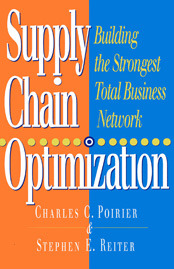Supply Chain Optimization
Charles Poirier (Author) | Stephen Reiter (Author)
Publication date: 06/01/1996
Bestseller over 20,000+ copies sold
Supply Chain Optimization illustrates how companies that create, distribute, and sell products or services can join forces to establish a supply network with an unbeatable competitive advantage. Poirier and Reiter explain how companies can successfully employ partnering, rather than working on improvements in isolation, to identify high opportunity initiatives across a total supply network. By applying key resources on focused opportunities and sharing the resulting savings, members of the network get larger results, faster, as well as funding for future efforts.
At the heart of Poirier's and Reiter's plan is a four-step model to mobilize joint effort and focus resources from suppliers, manufacturers, distributors, and retailers on initiatives that have a high pay-back potential. The authors have studied the successes of such influential retailers as Wal-Mart, K-Mart, Target, and Sears, all of which are laying the groundwork for how to use point-of-sale data to create quick-response alliances with selected suppliers who will take responsibility for replenishing stock to predetermined levels. Supply Chain Optimization explains how to develop such effective partnering techniques and demystifies the electronic data linkages that are necessary to make them work.
Supply Chain Optimization offers survival tools for companies of all sizes. The authors describe consortiums, or "share groups," of smaller companies that can compete with the volume leverage of large corporations, superstores, and warehouse stores. By analyzing their shared supply chain and pooling their available resources, these consortiums can find hidden savings to protect their profit margins and remain competitive in today's marketplace.
The book includes case studies that show what a wide range of companies are actually doing to achieve supply chain optimization. Companies profiled include: Financing Division of General Electric, Dial Corporation, Proctor & Gamble, Baxter Healthcare Corporation, Navistar/Goodyear, Packaging Corporation of America, Dominick's, Hart Mountain Corporation, and General Motors--Saturn.
Partnering requires more than technological expertise. Successful partnerships display high levels of cooperation expressed by the sharing of resources, time, energy, and the benefits achieved. Poirier and Reiter describe the many pitfalls that must be avoided, and create a vision of how firms can build on their existing supply initiatives to gain a greater competitive advantage in today's business world.
- Helps manufacturers, service companies, suppliers, distributors, and retailers find the hidden partnership opportunities in the business relationships they already have
- Explains how true partnering techniques can generate enhancements across a total supply network resulting in savings for all members of the network, as well as funding for future improvements
- Includes action studies to show how the concepts have been implemented
Find out more about our Bulk Buyer Program
- 10-49: 20% discount
- 50-99: 35% discount
- 100-999: 38% discount
- 1000-1999: 40% discount
- 2000+ Contact Leslie Davis ( [email protected] )
Supply Chain Optimization illustrates how companies that create, distribute, and sell products or services can join forces to establish a supply network with an unbeatable competitive advantage. Poirier and Reiter explain how companies can successfully employ partnering, rather than working on improvements in isolation, to identify high opportunity initiatives across a total supply network. By applying key resources on focused opportunities and sharing the resulting savings, members of the network get larger results, faster, as well as funding for future efforts.
At the heart of Poirier's and Reiter's plan is a four-step model to mobilize joint effort and focus resources from suppliers, manufacturers, distributors, and retailers on initiatives that have a high pay-back potential. The authors have studied the successes of such influential retailers as Wal-Mart, K-Mart, Target, and Sears, all of which are laying the groundwork for how to use point-of-sale data to create quick-response alliances with selected suppliers who will take responsibility for replenishing stock to predetermined levels. Supply Chain Optimization explains how to develop such effective partnering techniques and demystifies the electronic data linkages that are necessary to make them work.
Supply Chain Optimization offers survival tools for companies of all sizes. The authors describe consortiums, or "share groups," of smaller companies that can compete with the volume leverage of large corporations, superstores, and warehouse stores. By analyzing their shared supply chain and pooling their available resources, these consortiums can find hidden savings to protect their profit margins and remain competitive in today's marketplace.
The book includes case studies that show what a wide range of companies are actually doing to achieve supply chain optimization. Companies profiled include: Financing Division of General Electric, Dial Corporation, Proctor & Gamble, Baxter Healthcare Corporation, Navistar/Goodyear, Packaging Corporation of America, Dominick's, Hart Mountain Corporation, and General Motors--Saturn.
Partnering requires more than technological expertise. Successful partnerships display high levels of cooperation expressed by the sharing of resources, time, energy, and the benefits achieved. Poirier and Reiter describe the many pitfalls that must be avoided, and create a vision of how firms can build on their existing supply initiatives to gain a greater competitive advantage in today's business world.
- Helps manufacturers, service companies, suppliers, distributors, and retailers find the hidden partnership opportunities in the business relationships they already have
- Explains how true partnering techniques can generate enhancements across a total supply network resulting in savings for all members of the network, as well as funding for future improvements
- Includes action studies to show how the concepts have been implemented









